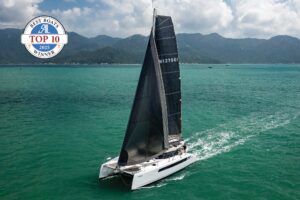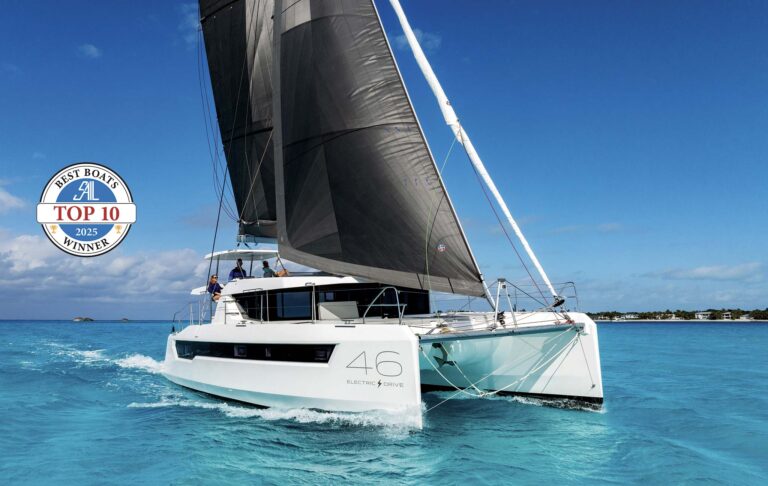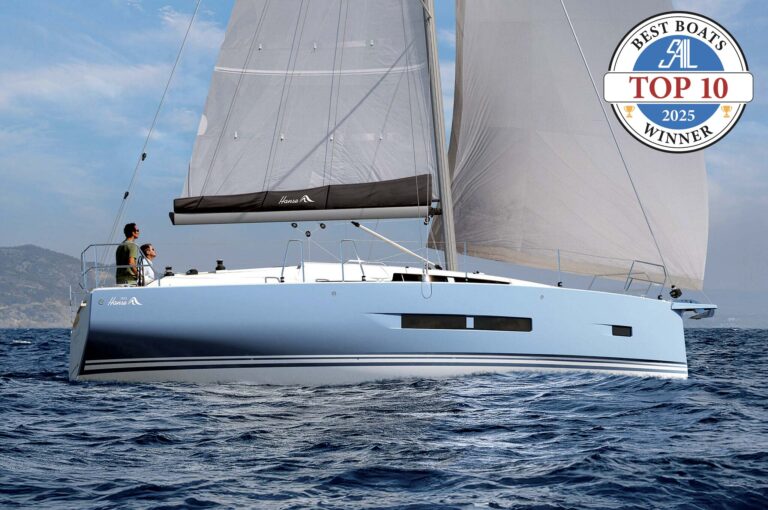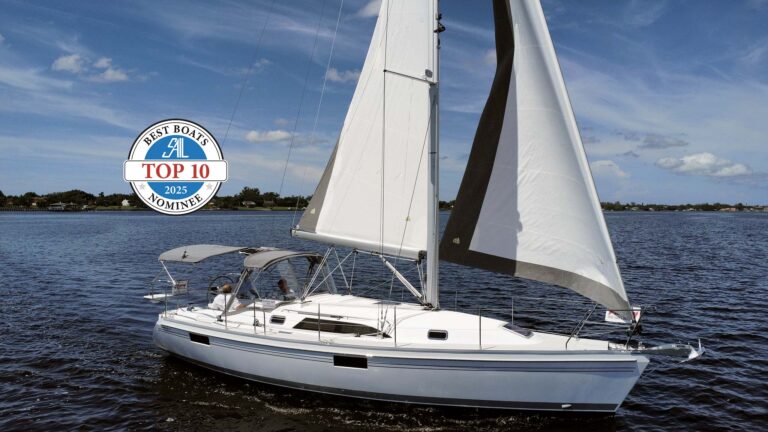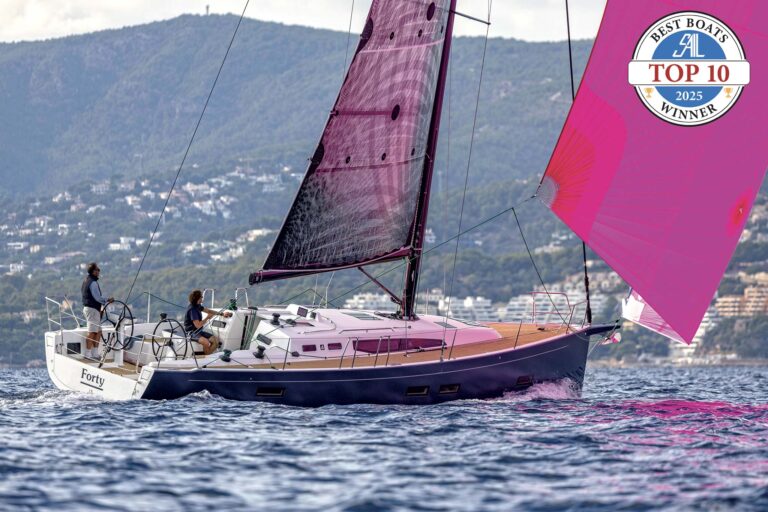
“Have you ever sailed on Lake Erie before?” Fred Hunger asks as he maneuvers his new Tartan 455 deckhouse sloop from the slip at the Cleveland Yacht Club on the Rocky River. It’s maybe a quarter mile from the docks to the river’s entrance onto the lake’s southwest corner, denoted by a stone jetty geysering with spray. The boisterous northwest breeze on this early August day has the flags even in this protected boat basin snapping.
“Nope,” I say. “I’ve always wanted to, though.”
“Nice,” Fred says, positively bouncing with anticipation. “Oh ho ho, you’re gonna get a Great Lakes sail today! There’s some nice waves left out there. Last night, this lake was angry.”
Fred is excited because it’s only the third time out in hull No. 1 of this new model from Ohio’s Tartan Yachts, and it’s the first time he’s had her out in real breeze. It’s also the first time the boat’s designer, Tartan Yachts stalwart Tim Jackett, is on board to get a feel for his latest creation that’s been on his mind for years and in the actual works since 2019.
As for me, I’m thinking a reef would be in order—it sure would be on most boats I have sailed—but Fred gleefully brushes off the notion as he raises the 507-square-foot Sobstad mainsail on the Forespar Leisure Furl boom using the electric winch at the starboard helm.
“This boat likes wind,” he says. “Trust me.”
And, as we barrel out of the river into white-capped Lake Erie, his statement is immediately confirmed. With just the main up, the boat is flying through 4- to 5-footers at 6 knots plus as we reach into the lake at about 65 degrees apparent in a gusty 25 to 30 knots of true breeze. Fred eases out the self-tacking jib and literally hoots as the boat bounds forward at 8 knots.
“It’s 50 miles to Canada, we could be there in about six hours,” Fred laughs. “Got your passport?”

Standing in the deep, secure, and notably dry cockpit, I look out over the long fetch of Lake Erie, feeling as though I’m riding a leaping charger as the boat powers through the roiled water.
Much of this performance and easy handling can be attributed to the CCR (Cruise Control Rig) sailplan—Tartan’s term for the Solent-rigged, nearly 100% self-tacking jib and 155% furling masthead reacher. They fly on a 64-foot, 3-inch, two-spreader carbon spar that is standard and built in-house by Tartan subsidiary AMP Spars. This is balanced with a 6-foot, 6-inch fin, cast-lead, beavertail keel incorporating 9,750 pounds of ballast. Keeping weight aloft to a minimum—and saving weight throughout the build—is key to being able to power up the boat across conditions, Tim says.
“There’s been a trend to the double-headsail rig and smaller headsails in cruising boats,” he says. “If you’re going to go with that rig, you have to make the commitment that you can power the boat up and have a stable enough boat that it’s still driving with small headsails in light air, but it can handle it in heavy air. It’s all those building blocks, and one of the final ones is that carbon rig, because the center of gravity is lower, it’s half the weight of aluminum, and it’s stiffer and has athwartship stability, pitching moment going through waves—it’s all just a huge benefit.”

The 455 represents a collaboration between Fred and Tartan. A lifelong sailor and former racer, Fred, along with his wife, Marilyn, bought a new Tartan 3700 in 2007 to cruise with their three kids on Lake Erie and northward. They sailed it for 12 years when they decided they wanted something bigger. Now with their kids grown and their first grandkid on the way, they wanted a stout, roomy, bluewater boat to cruise doublehanded with occasional friends and family through the Great Lakes and eventually out the St. Lawrence to Maine, New England, and some of the East Coast.
“I’ve kind of always been fond of the pilothouse model, and Tim approached us with this new design,” Fred says. “Knowing we’d be the first hull, we kind of worked together on some of the design elements with storage and optional things that could go on the boat.”
Based in Painesville, Ohio, Tartan has long been known for its powerful, fast, traditional designs—most of which were drawn by Tim. Now with Tartan for 47 years, his first full design was the Tartan 31 in 1985. And though the 455 hull is pure Tim Jackett—sleek, deep, purposeful—the boat is a bit of a departure with its focus on predominately one-level living and sailing via the big aft cockpit and deckhouse.
Tim says the concept grew as he worked on Tartan’s Legacy line of sedan powerboats, whose combination of helm deck and walk-out cockpit make for “a nice way to be on the water.” He also noted that many Tartan owners typically enclose their cockpits with full canvas for protection from the elements. Why not give them the best of both worlds by creating an interior helm station with 360-degree visibility, heat, AC, and all the comforts, complementing it with a dual-helm cockpit to provide what he calls the “wind-in-the-face” experience Tartan sailors love?
The result is an intriguing hybrid that sails like a witch, presents a sleek, handsome profile while still carrying the large deckhouse, and provides some seriously plush powerboat comforts.
The salon resembles a sedan powerboat in layout, with galley to starboard, dinette opposite, and big, laminated glass windows all around. The galley includes a three-burner Force 10 stove, a top-loading freezer and front-loading fridge, and some clever, immense pull-out drawers for storage. Countertops are Granicoat—a tough, elegant coating sprayed onto a fiberglass, balsa-cored backing, saving weight and eliminating cracking.

Forward of the galley, the inside helm has room for two on the Llebroc ultraleather captain’s seat facing a stainless steel wheel, throttle, and 12-inch Raymarine plotter, with electrical panels in easy reach. Opposite is the companion seat (also Llebroc ultraleather), with a nav station/chart table forward. At Fred’s request, the backrest cants forward or back depending on whether you want to look forward or aft to the dinette (although this is admittedly a little awkward, since your feet basically rest on the dinette seat).
It’s worth noting that the inside helm steering is hydraulic, while at the two cockpit helms, steering is traditional sailing feel via chain and cable; a toggle switch at the aft helm easily disables the hydraulic steering. The autopilot drives the same hydraulic ram serving the interior helm, so only one pump is needed.
Overhead, owners can opt for an immense Lexan skylight—about 4 by 6 feet—or two 120-amp solar panels, and opening hatches provide fresh air over the helm and nav seats.

A hydraulic lift raises the sole (which is three-eighths-inch teak laminated to solid substrate) to access the engine room, where the 75-hp Volvo runs a four-blade folding prop on a saildrive. The genset is just aft of the main engine, with all mechanicals easily accessible. All this space, visibility, and handy access means maintenance is made easier.
From this main living area, four steps down and forward lead to the sleeping spaces. (The boat’s two 8D AGM house bank batteries sit beneath the steps—right on top of the keel—that lift on a hinge for access.) In this three-cabin layout, the owner’s cabin occupies the V-berth with en-suite head and centerline queen bed, while two doubles are on each side sharing a second head portside in the passage. Deep and centered in the boat, these amidships cabins would clearly be quiet and stable for offshore sailing. In the two-cabin layout, the port cabin extends forward, and the day head and shower move to the starboard side.

The big, keel-stepped mast fits seamlessly into the passage here, and forward in each double cabin, reassuringly massive chainplates—bolted to three-quarter-inch plates of solid fiberglass imbedded into the main cabin bulkhead—are polished like artwork.
Throughout, Tartan’s superlative joinery—maple or cherry—provides a rich, warm, and very traditional yachting vibe, the polar opposite of the Euro-styling so prevalent on many other production models today. With the exception of some cabinet faces and pull-out drawers that are outsourced to local Amish craftsmen, all of Tartan’s joinery and finishing is done in-house, and the attention to detail is precise. For example, rather than cutting two joints to insert a curved piece on a fiddle or cabinet top, each piece is a single, solid laminate to ensure that grain and color remain constant throughout.
Heading aft, it’s one step up (Fred has put a little wine cellar in here) from the salon into the cockpit, via a sliding door on a Harken track. The cockpit, too, has a distinctly hybrid flavor. The tall back of the deckhouse incorporating the door feels powerboat-y, and the cockpit seats are extremely deep, lending to the feeling of security but limiting any real visibility forward. In the storage spaces beneath, Fred has installed a watermaker and icemaker. Short coamings on either side house jammers for all sailhandling lines leading to two big, electric, primary Harken winches in front of each helm.

In the center, a single pedestal with small fold-out table sides provides storage for winch handles and such and houses the engine start, tach, and oil pressure gauges.
A short step up and aft leads to what you could call the aft helms platform, and here, it’s all pure sailing. Carbon pedestals, built in-house and light enough to lift with one hand, hold Jefa wheels as well as various controls, with a Raymarine plotter and stout grabrails on top of each. Small seats occupy the back corners of the stern pulpit, whose rails are about 3 feet tall, offering excellent security. The transom is a drop-down platform, managed with a simple block system.

A nearly full-width traveler crosses the deckhouse with mainsail control lines led aft, keeping the cockpit clear. The hydraulic backstay and vang are controlled via a remote panel on the outboard portside coaming. Access forward is up a step to the side decks, with ample handholds along the way. Shrouds are inboard, making for a brief narrow point, before reaching the foredeck with anchor locker, Quick DP2 windlass, and stout anchor platform with double roller, which also incorporates the tack points for the headsails.
Inside and out, the 455 conveys strength. Hull and deck are laminated with vinylester in a one-shot vacuum-infusion process to maximize stiffness and minimize weight. The hull is cored with three-quarter-inch PVC and the decks with three-quarter-inch balsa. Where hardware is to be mounted, a “window” in the core provides a space where an aluminum plate is infused as part of the laminate.
“The entire structural laminate, hull and deck, is cured together so you wind up with a primary bond,” Tim says, eliminating weaker, secondary bonding of structural materials. Structural fiberglass timbers fore and aft are bonded to the hull to carry mast and keel loads, and all structural bulkheads are fiberglassed to the hull and deck.
All of this makes for a solid build, evident by how quiet it is when I go below, despite the sea state above.
We sail into the lake for an hour or so, eschewing a run under the reacher in this breeze and instead opting for a simple, easily executed tack to head back in. With the former racer in Fred fired up, he’s encouraging me to sail for speed in the waves, and the boat is effortlessly pushing between 8 and 9 knots at an apparent wind angle of about 75. I have to muscle the helm a bit; since this shakedown sail, Tim has added more area to the rudder’s leading edge to resolve the heavy helm. Even so, the rudder—on a carbon post with stainless steel bearing sleeves—makes it pretty easy to find a groove as we charge back toward the coast.
To some extent, I wish the wind were a little less feisty and we had more time for experimenting on more points of sail, but none of us is complaining. My only real regret, after we zoom past the jetty and into river’s shelter, is that I didn’t bring my passport.

Tartan 455
LOA/LWL 45’6”/39’6”
Beam 14’1”
Draft (beavertail) 6’6”
Ballast 9,750 lbs
Displacement 25,750 lbs (light)
Sail Area Upwind/Offwind 977.5 sq ft/1,324.6 sq ft
Power 75hp Volvo with saildrive
Designer Tim Jackett
Builder Tartan Yachts, Painesville, Ohio tartanyachts.com
Base Price $899,000


